Suchergebnisse
Neue Publikationen des IEA AFC Annex 35 "Brennstoffzellen für portable Anwendungen"
Im IEA AFC Annex 35 wurden fünf Papers rund um das Thema "Brennstoffzellen für portable Anwendungen" publiziert.
IEA 4E PECTA: Leistungselektronik zur Steuerung und Umwandlung elektrischer Energie (Arbeitsperiode 2019 - 2021)
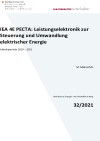
Der Power Electronic Conversion Technology Annex (PECTA - Leistungselektronik zur Steuerung und Umwandlung elektrischer Energie) ist einer von vier Annexen im IEA 4E Technologieprogramm (TCP). PECTA soll dabei das Effizienzpotential unter Verwendung und durch Integration von Halbleitern mit weitem Bandabstand (Wide-Bandgap WBG) in Leistungselektronikapplikationen evaluieren und als unabhängige Informations- und Wissensplattform für politische Entscheidungsträger zum Thema WBG dienen.
Schriftenreihe
32/2021
M. Makoschitz
Herausgeber: BMK
Deutsch, 49 Seiten
Downloads zur Publikation
IEA 4E EDNA: Bericht “Small Network Equipment: Considerations for Energy Efficiency Policy” (2021)

Der Bericht fokussiert die Energieverbräuche von „Small Network Equipment“ (SNE), also kleinen Netzgeräten aus Haushalt- und Gebäudesektoren. Auf Grundlage der technischen Analyse ausgewählter Produkte werden Empfehlungen zur Förderung der Energieeffizienz von SNE ausgesprochen.
Herausgeber: IEA 4E EDNA Task 20 Small Network Equipment, Juli 2021
Englisch, 32 Seiten
Downloads zur Publikation
IEA AFC TCP: Current and Future Technologies – Costs, Performances and Potential

Die Studie liefert einen Überblick über technische Kenndaten stationärer Brennstoffzellen (Fokus: PEFC und SOFC) in Großanwendungen und MikroKWK, analysiert finanzielle Aspekte und liefert Prognosen für die zukünftige Entwicklung.
V. Cigolotti, M. Genovese
Herausgeber: IEA AFC TCP, 2021
Englisch, 22 Seiten
Downloads zur Publikation
IEA 4E: Bericht "Wie gut nutzen wir Smart Home Technologien? Die Rolle der Nutzerfreundlichkeit" (2021)

Smart Home Technologien (SHT) können durch die Möglichkeit, Geräte energieeffizient zu nutzen, dazu dienen, Treibhausgasemissionen einzusparen. Der Bericht beschreibt, wie eine mangelnde Nutzerfreundlichkeit bei der Einrichtung und dem Betrieb von SHT dazu führen, dass vor allem im Haushaltsbereich das Effizienzpotential von SHT nicht voll ausgeschöpft wird, und schließt mit Maßnahmen zur Verbesserung der Nutzerfreundlichkeit ab.
Herausgeber: IEA - 4E, Oktober 2021
Englisch, 43 Seiten
Downloads zur Publikation
IEA 4E EDNA: Policy Brief "Der Einfluss netzwerkverbundener Geräte auf Datenverkehr und Energieverbrauch von Daten- und Rechenzentren (Upstream consequences)" (April 2020)

In Folge der Zunahme netzwerkverbundener Geräte steigt der weltweite Datenverkehr, was sich auf den Energiebedarf von Rechenzentren auswirkt. Der Policy Brief stützt sich auf die Inhalte von zwei EDNA Berichten und benennt wesentliche Trends und Stichpunkte. Abschließend werden Empfehlungen zur Reduzierung des weltweiten Energieverbrauchs von Rechenzentren gegeben.
Herausgeber: IEA 4E, April 2020
Englisch, 2 Seiten
Downloads zur Publikation
IEA ECES Annex 28: Final Report "Distributed Energy Storage for the Integration of Renewable Energy" (2018)

Der Bericht gibt einen Überblick über die Rolle von dezentralen Energiespeichern und die potenziellen Speicherkapazitäten für die Integration erneuerbarer Energien auf einem wirtschaftlich wettbewerbsfähigen Niveau.
Hauer Andreas und Christian Doetsch
Herausgeber: IEA ECES Annex 28, 2018
Englisch, 111 Seiten
Downloads zur Publikation
IEA ECES Annex 30: Final Report "Applications of thermal energy storage in the energy transition” (2018)

Der Bericht gibt einen Überblick über die Entwicklung einer Analysemethodik zur Speicherintegration, der Bestimmung von wichtigen Leistungsindikatoren und zeigt Fallstudien von integrierten TES-Systemen in unterschiedlichen Prozessen.
Gibb Duncan, Seitz Antje, Johnson Maike, Romani Joaquim, Gasia Jaume, Cabeza Luisa F. and Gurtner Richard
Herausgeber: IEA ECES Annex 30, 2018
Englisch, 157 Seiten
Downloads zur Publikation
IEA ECES Annex 31: Final Report "Energy Storage with Energy Efficient Buildings and Districts: Optimization and Automation” (2018)

Der Bericht gibt einen Überblick über das multidisziplinäre Feld der Energiespeicherung in Gebäuden und Regionen und bildet ein breites Spektrum in der Modellierung, Optimierung und Leistungsbewertung ab.
Fariborz Haghighat
Herausgeber: IEA ECES Annex 31, 2018
Englisch, 341 Seiten
Downloads zur Publikation
IEA AFC Annex 34 - Renewable Hydrogen: Modular Concepts from Production over Storage to the Consumer (2021)

Die Veröffentlichung beschreibt neben den Technologien der grünen Wasserstoffherstellung die Möglichkeiten der Wasserstoffspeicherung und modulare Ansätze von Wasserstoff-Infrastrukturen.
Alexander Trattner, Martin Höglinger, Marie-Gabrielle Macherhammer and Markus Sartory
Herausgeber: Chemie Ingenieur Technik
Englisch, 12 Seiten
IEA EBC Annex 67: Annual Report 2015
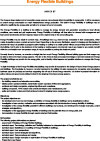
Im Jahresbericht 2015 wird ein kurzer Überblick über die Ziele, Arbeiten und den Fortschritt im EBC Annex 67 inklusive der teilnehmenden Länder gegeben.
Søren Østergaard Jensen
Herausgeber: DTI, IEA-EBC Programm
Englisch, 2 Seiten
Downloads zur Publikation
IEA EBC Annex 63: Energieraumplanung – Ein Schlüssel zur Energiewende?
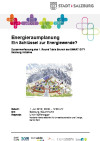
In der Zusammenfassung sind wesentliche Informationen zur Energieraumplanung in der Schweiz sowie die zentralen Aussagen der Round Table Diskussionen zusammengefasst.
Herausgeber: Salzburger Institut für Raumordnung und Wohnen, IEA EBC Annex 63
Deutsch, 7 Seiten
Downloads zur Publikation
IEA DSM Task 24 Phase II: ECEEE Summer Study - Workshop Minutes (2017)

Protokoll der Workshops, die im Rahmen des IEA DSM Task 24 bei der ECEEE Summer Study 2017 abgehalten wurden.
Rotmann S., Kallsperger T.
Englisch, 12 Seiten
Downloads zur Publikation
Neue Publikationen im IEA EBC Annex 61
In den Subtasks des IEA EBC Annex 61 wurden sechs Berichte zum Thema "Deep Energy Retrofit" veröffentlicht.
IEA EBC Annex 57: Evaluierung der konstruktionsspezifischen CO2-Emissionen und der grauen Energie
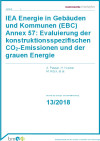
Im IEA-EBC Annex 57 wurden Methoden zur Evaluierung der konstruktionsbezogenen - Grauen - Umweltwirkungen von Gebäuden sowie mit anderen internationalen Best-Practice-Projekten und deren Herangehensweisen ausgewertet. Auf diesen Erkenntnissen aufbauend wurden methodische Richtlinien sowie Maßnahmen zu deren Anwendung auf internationaler Ebene und zur Planung von Gebäuden - mit geringerer Grauer Energie und Grauen Treibhausgasemissionen - abgeleitet.
Schriftenreihe
13/2018
A. Passer, H. Kreiner M. Röck, et al.
Herausgeber: bmvit
Deutsch, 87 Seiten
Downloads zur Publikation
IEA HPT Annex 42: Wärmepumpen in intelligenten Energienetzen nachhaltiger Städte
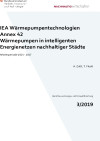
Der IEA HPT Annex 42 zielte darauf ab, die technischen sowie ökonomischen / regulatorischen Rahmenbedingungen von weitgehend vom Stromanbieter gesteuerten Wärmepumpen zum Lastausgleich in Österreich zu analysieren. Weiters wurden die Auswirkungen auf thermische Verbraucher und mögliche Potenziale untersucht, um darauf basierend ökonomische Anreizmodelle zur Lastverschiebung heraus zu arbeiten.
Schriftenreihe
3/2019
A. Zottl, T. Fleckl
Herausgeber: BMVIT
Deutsch, 93 Seiten
Downloads zur Publikation
IEA 4E EMSA: Tool "DTI Hydracalc" (2021)

Das unter dänischer Leitung entwickelte DTI Hydracalc ist ein frei verfügbares Werkzeug, das alle möglichen Regelungsstrategien für eine zyklische Hydraulikanlage auswertet.
Sandie B. Nielsen
Herausgeber: Danish Technological Institut, 2019
Englisch, 62 Seiten
IEA ISGAN: TSO-DSO Coordination: The UK Case (2022)

Dieser Bericht beschreibt die Erfahrungen und Ansätze in Großbritannien, um die Koordination von Übertragungs- und Verteilnetzbetreibern (TSO, DSO) zu verbessern und so Flexibilitäten im Stromnetz besser zu nutzen.
Herausgeber: Energy Systems Catapult, ISGAN Annex 9, März 2022
Englisch, 7 Seiten
Downloads zur Publikation
IEA IETS Annex 19: Nationaler Newsletter #7 - Elektrifizierung der Industrie (2022)

Schwerpunktthema des Newsletters ist der zweite vom österreichischen Konsortium durchgeführte Subtask-Workshop.
Simon Moser
Herausgeber: IEA IETS 19, Herbst 2022
Deutsch
IEA UsersTCP SLA 2.0: Inclusive and Community-Oriented Approaches to a Social License to Automate (Working period 2022-2024)
The energy transition is critical in solving the climate crisis. Automated demand side management has great potential in this process but struggles with social acceptance. In SLA2.0, the role of gender and diversity factors concerning flexibility and engagement was analysed, and the potential contribution of energy communities to a social license for automation was explored. Based on the findings, flexibility profiles and recommendations were developed.
